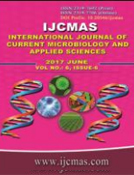


 National Academy of Agricultural Sciences (NAAS)
National Academy of Agricultural Sciences (NAAS)

|
PRINT ISSN : 2319-7692
Online ISSN : 2319-7706 Issues : 12 per year Publisher : Excellent Publishers Email : editorijcmas@gmail.com / submit@ijcmas.com Editor-in-chief: Dr.M.Prakash Index Copernicus ICV 2018: 95.39 NAAS RATING 2020: 5.38 |
Fifty five crosses from 11 x 11 diallel excluding reciprocals were studied to assess the magnitude of heterosis over Better parent (BP) and standard check (SC) for fruit yield and its components in Okra [Abelmoschus esculentus (L) Moench]. Analysis of variance manifested highly significant differences for different characters which indicating the considerable genetic diversity among the material studied. For number of fruit per plant hybrids HRB-55 x AOL-09-17(87.58%), JOL-09-8 x AOL-09-17 (71.17%) and AOL-09-17 x JOL-09-7(62.48%) depicted significant heterosis over better parent. For standard heterosis the crosses HRB-55 x AOL-09-17(71.08%), JOL-09-8 x AOL-09-17(49.37%), AOL-09-17 x JOL-09-7(41.78%) and JOL-55-3 x HRB-55(26.99%) exhibited most superior performance. For total fruit yield per plant heterobeltiosis ranged from -24.62 to 53.93 and total 15 hybrids showed positive response and highest performing hybrids are JOL-09-8 x JOL-09-7 (53.93 %), JOL-09-8 x AOL-09-17 (37.99 %) and JOL-09-12 x AOL-09-2 (37.76 %). The values for standard heterosis ranged from -12.00 to 53.88 per cent and Seventeen crosses exhibited positive significant standard heterosis. The cross HRB-55 x AOL-09-17 exhibited the highest magnitude of heterosis to the extent of 53.88 per cent over standard check for fruit yield per plant. Other best performing crosses on the basis of merit are HRB-55 x AOL-09-17 (53.88 %), JOL-09-8 x AOL-09-17 (48.83 %) and AOL-09-17 x JOL-09-7(46.17 %) respectively and the crosses can be used for exploitation of hybrid vigor on commercial scale. The study reveals good scope for exploitation of heterosis in okra for high yield.
 |
 |
 |
 |
 |